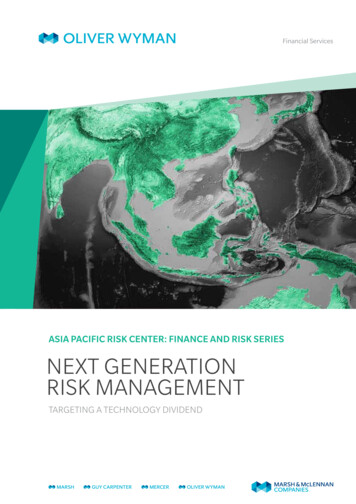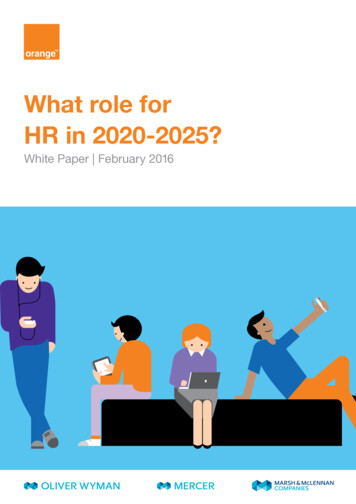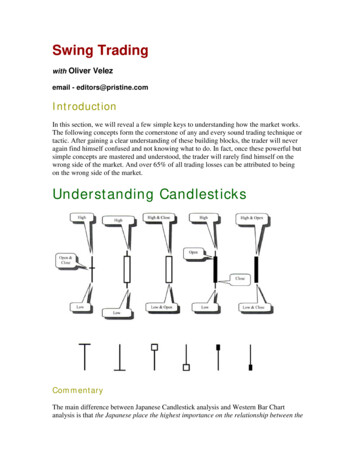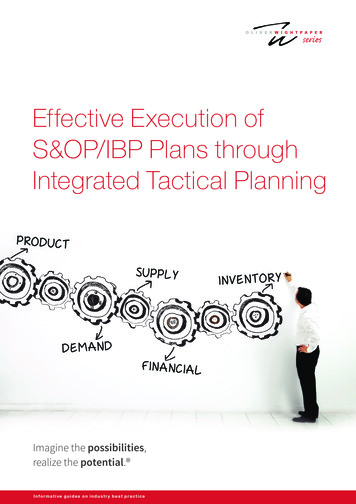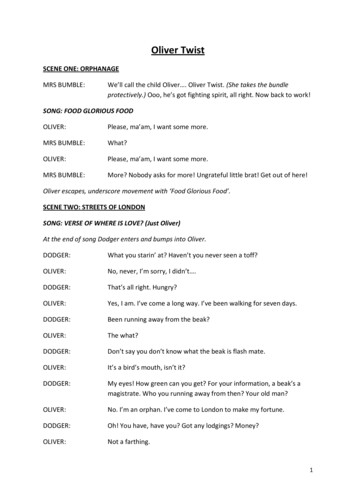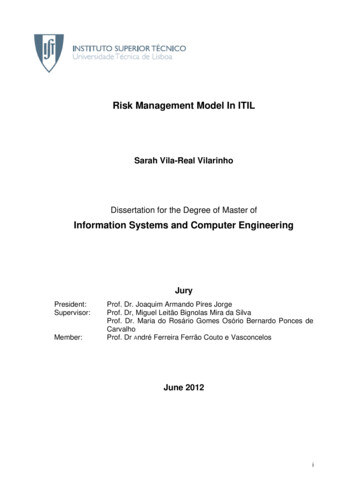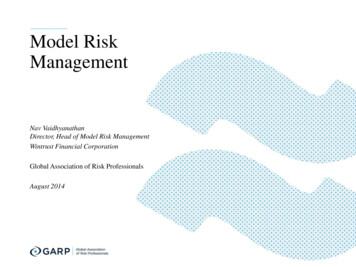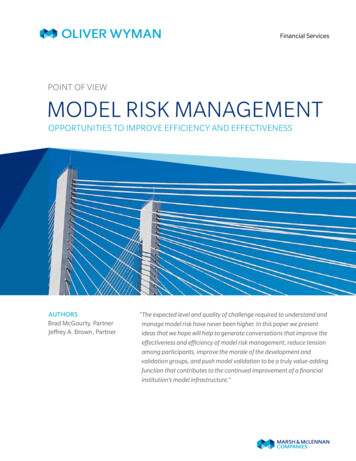
Transcription
Financial ServicesPOINT OF VIEWMODEL RISK MANAGEMENTOPPORTUNITIES TO IMPROVE EFFICIENCY AND EFFECTIVENESSAUTHORSBrad McGourty, PartnerJeffrey A. Brown, Partner“The expected level and quality of challenge required to understand andmanage model risk have never been higher. In this paper we presentideas that we hope will help to generate conversations that improve theeffectiveness and efficiency of model risk management, reduce tensionamong participants, improve the morale of the development andvalidation groups, and push model validation to be a truly value-addingfunction that contributes to the continued improvement of a financialinstitution’s model infrastructure.”
INTRODUCTIONSince the financial crisis, regulatory standards, and the corresponding capabilities of financialinstitutions, have increased for model development, validation, and broader model riskmanagement (MRM). During the same period, a surge of high-priority, time-sensitive modeldevelopment and re-development was triggered by the annual CCAR cycle and relatedregulatory feedback. Similarly, institutions such as insurers and U.S. subsidiaries of foreignfinancial institutions are now undertaking significant model development efforts as they becomesubject to additional regulatory requirements such as CCAR and resolution planning. As a resultof the struggle to enhance internal capabilities to address the changing environment, a strainhas been placed on the model development and validation functions, which commonly leads toorganizational tension and inefficiency. We believe there are opportunities to refine the way thatMRM and developers interact to improve efficiency and effectiveness without compromising theneed to maintain independence and provide challenge.There has been a steady evolution of model risk management and regulatory expectationsfor model validation. In 2000, the OCC released guidance that set expectations for the modelvalidation function.1 As dependence on models grew in banking, expectations for effective modelrisk management grew to include an agenda broader than model validation, as described inregulatory guidance in 2011.2 Meanwhile, internal expectations have also evolved. In particular,before the financial crisis, modelers tended to have more freedom to independently developmodels that they felt were reasonable for the intended purpose without strict governance oroversight. Over time, this freedom was restricted as the level of review and criticism of their workincreased due to the evolution of modern MRM practices.While most industry practitioners would agree that these changes were for the broader benefit ofinstitutions’ ability to manage risk, they have led to more tension between model developmentand validation (and at times, the line of business experts impacted by the process). For example,model developers may resist the additional MRM scrutiny and feedback that did not exist beforethe financial crisis. One source of this tension can occur when the model risk managementfunction is overly focused on checking compliance with specific process requirements and, as aresult, the function operates too mechanically by following prescribed steps to review a model.We believe that these challenges leave opportunities to improve upon existing practices andsave time and resources. Refining the culture of interactions between model developers andmodel risk can improve efficiency and make these interactions less stressful and frustrating. Inaddition, the MRM function can increase effectiveness by focusing on challenging models’ overallconceptual appropriateness and more deeply understand the business implications of modellimitations and weaknesses.1 Office of the Comptroller of the Currency, OCC Bulletin, Model Validation, OCC 2000-16 (May 30, 2000)2 SR11-7; OCC2011-12. Federal Reserve Board & Office of the Comptroller of the Currency, Supervisory Guidance on Model RiskManagement (April 4, 2011)Copyright 2016 Oliver Wyman
Through our work with financial institutions – both on model development and model validation – wehave developed a deep appreciation for the perspectives of both groups and have observed practicesthat are more (and less) effective for the management of model risk. In this paper, we share a noncomprehensive list of pitfalls we have observed across the industry and we suggest alternativeapproaches to improve interactions between model development and model validation functions, toenhance model risk management processes, and to ultimately improve the quality of analytical toolsat financial institutions. The exhibit below illustrates areas where we commonly observe challengeswithin model development and model risk management organizations; each area will be discussedfurther in the sections that follow. We expect that institutions will have made progress along some ofthese dimensions, but likely not all of them. We hope that readers of this paper will find our observationsand suggestions thought-provoking and useful as financial institutions and insurers consider ongoingenhancements to modeling and model risk management.3Exhibit 1: Overview of areas that pose challenges in a typical modeling/model risk management framework1MODEL RISK MANAGEMENT GROUP CULTURE (OBJECTIVES, TEAM MANAGEMENT AND DEVELOPMENT) Model validation effectiveness is commonly measured by the group’s ability to execute an established list of model review taskswithin allowed timeline Inconsistent levels of resources and talent may exist between model development and validation teams Typically limited flexibility for resources to rotate roles between model development and validation due to institutions’ concernsover maintaining independence2GOVERNANCE, POLICIES, OVERSIGHT At times, debated issues cannot be resolved easily and there is no clear escalation path to reach a conclusion “Failing” a model causes significant re-work and may result in missed deadlines (e.g., for CCAR)34DEVELOPMENT, VALIDATION PLANNING AND EXECUTIONModel developmentIndependent model validationIssue identification and resolution We see increasing participationfrom model validation in modeldevelopment meetings Formal model validation tendsto follow developmentafter the model is finalizedand documented Validation template existswhich provides guidance onrequired tests/analyses However, the developmentprocess still commonlyproceeds to completion beforegetting formal, writtenfeedback from the modelvalidation team Model development guidelinescommonly exist, but not jointlyagreed-upon by developmentand validationSource: Oliver Wyman analysis3 It is important to note that any program to improve efficiency of the interactions between model development and model riskmanagement must not violate the fundamental requirement that model risk management maintain independence and provide effectivechallenge. This is non-negotiable when considering potential improvement opportunities.3
1. OPPORTUNITIES TO ENHANCE MODELRISK MANAGEMENT GROUP CULTUREA primary goal of model validation should be to add value byimproving the institution’s model infrastructure. This must besupported with hiring, training, and overall model risk cultureCOMMON PITFALLSHistorically, model validation was more of a “checking” function to confirm that modelswere accurate and conceptually reasonable. As the number of and reliance upon models hasincreased over time, model risk management has evolved beyond validation to include abroader set of activities requiring additional skills (particularly, skills related to well-controlleddata management, detailed business knowledge to support conceptual assessment, and strongwritten and verbal communication skills). However, since model risk is not easily measurable,some institutions manage model risk by the success in executing a list of activities ratherthan seeking opportunities to more critically assess individual models, including a deeperunderstanding of the model’s purpose as it relates to the business and of the impact of modelweaknesses and limitations.In addition, as we discuss below, at times we observe that the model development and modelvalidation teams have imbalanced skill levels, which can cause frustration and erode the mutualrespect that is critical to an effective model validation process. Even though the fundamentalskills necessary to develop and validate models are similar, there is infrequent movementbetween model development and model validation functions, which reduces the naturalcollegiality, culture exchange, and mutual understanding which such movement might create.REFINEMENT OPPORTUNITIESModel risk management cultureExpectations should be set that model validation should not only be performed to execute a setlist of pre-defined activities to check the conceptual and analytical performance of models. Thevalidation function should also seek to provide critical review of each individual model and worktowards improving the bank’s overall quantitative capabilities and to better understand andmanage model risk to create business impact. To achieve this shift in culture, these expectationsneed to be clearly communicated from senior management and incentives should be alignedCopyright 2016 Oliver Wyman
to achieve this (i.e., performance should not only be measured against the ability to complete acheck-list of tasks by a specified deadline but also for maintaining business perspective and forproductive, value oriented, interactions with model developers and the lines of business).StaffingSome institutions have traditionally placed more focus on hiring strong resources into the modeldevelopment function and staffed model validation as a secondary priority, with varying levels ofskill. Additionally, either due to past experience or current level of interaction, model developersmay have deeper business knowledge of the portfolios with which they are working. Regulatorshave given clear guidance that model validation resources must be equally qualified to allowthem to challenge and engage in academic debates with the model developers. While progresshas been made in this area, financial institutions should be careful to maintain a balanced level ofskill and business expertise across the development and validation groups. Beyond meeting theprescribed regulatory expectations, hiring equally qualified resources across groups will promotemore productive discussions about the nuances, and potential shortcomings, of models beingdeveloped and reviewed.Roles & responsibilitiesAs consultants, we have the opportunity to frequently change roles across model development,model validation, and advising on overall model risk management governance and policies. Thisgives us an appreciation and empathy for how other individuals in the process feel, particularlywhen debates arise. This experience provides a valuable perspective and can help to facilitatemore collaborative and efficient interactions between the model development and validationfunctions. Financial institutions may find it beneficial to allow this sort of movement across roleswhere developers and validators can change roles and gain broader experience. This approachcan give staff a better appreciation for the “other side,” improve job satisfaction, and reduceturnover. Indeed, we hope that one outcome of the ideas to reduce tension presented throughoutthis paper is a greater enjoyment of the work and a corresponding lower rate of turnover. It isimportant that these refinements do not (in reality or in appearance) impair the ability of the modelvalidation team to remain independent or provide effective challenge to the model developmentprocess. For example, people should generally not rotate to the specific team with which they wereengaged as either a developer or a validator.5
2. OPPORTUNITIES TO ENHANCE MODELRISK GOVERNANCEModel validation findings are necessarily controversial at times.Model governance processes should support the enforcement andtimely resolution of identified issuesCOMMON PITFALLAs issues are identified by model validation, developers may agree (e.g., where a mathematicalerror has occurred) or hold their ground and debate its validity or importance. At times,agreement on the appropriateness of an issue cannot be reached and an unnecessary amountof time is invested in debating the issue, which causes further inefficiency and tension betweenmodel developers and validation (which we have observed persist even into subsequentinteractions regarding unrelated models). This conflict is particularly sensitive in cases wheremodel validation intends to “fail” a model, which can have an impact on downstream deadlinessuch as the submission of a bank’s capital plan.REFINEMENT OPPORTUNITIESThe model governance structure should include an escalation channel that can quickly resolvedisputes and support enforcement of issues, as needed. In addition, the governance processshould allow for the reconsideration of the criticality of issues identified by model validation (toa less severe level) from an independent perspective, where appropriate. Institutions shouldalso have a solution where a model can potentially be “failed” without significant negativeconsequences (e.g., impact on CCAR submission timeline). For example, validation may approvea model contingent upon resolving specific short-term and long-term remediation requirementsif a model has conceptual or analytical performance issues.The ultimate goal is that by having clear escalation channels, time spent on counter-productivearguments between model developers and validation will be reduced. Further, again usingCCAR as an example, by having an option where model validation can “fail” a model withoutjeopardizing the bank’s capital plan submission, pressure is reduced on the validation team toallow sub-par models to pass due to looming deadlines. Where implemented effectively, despitein some ways ‘softening’ the approach of model risk management, these governance practicesshould overall strengthen, not weaken, the ability of model risk to provide effective challenge.Copyright 2016 Oliver Wyman
3. OPPORTUNITIES TO ENHANCE PLANNINGAND SEQUENCING OF MODEL DEVELOPMENTAND VALIDATION3A.The stakes are high when formal validation feedback comes onlyafter development is fully or mostly completeCOMMON PITFALLModel development and model validation processes tend to be organized sequentially withlimited formal communication during the development process. In some cases, models aredeveloped – sometimes without providing any notice to the validation team – and only sharedwith model validation after the development and model documentation are at least mostlycompleted. Since model development tends to take weeks or months to complete, there hasbeen a significant amount of effort invested in the process and any required revisions identifiedby the model validation team could drive significant re-work of the model development processand documentation. It is not surprising that there is reluctance to agree to changes that wouldtrigger this re-work and it is not surprising that the natural reaction to model validation findingstends to be defending the current approach and pushing back on any requests to revisit earlierparts of the development process.Financial institutions have recognized this in some cases and have made varying attempts toinvolve model validation sooner in the development process. For example, model validationmay be included as a silent participant during model development meetings. However, withouta more formal process to review the proposed conceptual and analytical model approach andprovide feedback, this “light” participation may suggest implied acceptance of approachesthat were not immediately rejected. This can actually lead to issues later in the process if thoseapproaches are then challenged at a later stage in the validation process once a more formal/thorough review has been performed.7
REFINEMENT OPPORTUNITIESModel risk management can work with the model developers to identify opportunities toembed formal check-points where model developers have an opportunity to receive feedbackon planned conceptual approaches, development data, and initial results (see Exhibit 2). Thevalidation team can ask questions and point out areas that will be explored in more detail duringformal validation so developers can anticipate the need to consider potential issues proactivelyduring the ongoing development. Findings of these initial conceptual reviews should ideally bememorialized through a brief memo, which will encourage more careful consideration of the earlyassessment by the validation team. By prioritizing discussions on key topics such as conceptualapproach, available development data, and anticipated model limitations/weaknesses, anydisagreements between model developers and validation can be surfaced and resolved earlierin the process, reducing the risk of reworking significant components of the model or puttingmodel implementation deadlines into jeopardy. Initial reactions to this process may suggest itadds time, but a well-written memo can be quickly incorporated into the final model validationreport to offset the effort invested earlier in the process. It is important that these interactions donot (in reality or in appearance) impair the ability of the model validation team to remain independentor provide effective challenge to the model development process. The considerations raised canbe either incorporated into the models or not incorporated, without penalty, with thoughtfuljustification provided.3B.Model developers will struggle to accommodate validation requestsunless validation support is included in their work planCOMMON PITFALLA further risk of the typical sequencing of activities (where model validation occurs only aftermodel development has been largely completed) is that the validation team will have morequestions and requests to understand the nuances of the model being reviewed. Meanwhile,developers have moved onto to other development activities and not planned for the requiredlevel of interaction. The result? As questions and requests for additional information/analysesarise, the model developers are focused on a different task and have not allocated sufficienttime to engage with the effective challenge process. In order to keep pace with their otherdeliverables, model developers feel they must push back against validation requests, which addsto tension between the two groups.Copyright 2016 Oliver Wyman
REFINEMENT OPPORTUNITIESThe model development workflow should allow for 10-20% of a developer’s time to support thevalidation process after submission of a model for review. A structure which allows validationrequests to be addressed during the normal course of business, rather than requiring extra effortand long hours, reduces the reluctance and pushback caused by necessary validation requests.Planning adequate time to support validation avoids developers feeling overly stressed andimproves morale both for the model developers (who less frequently need to put in long hoursto deal with model validation requests) and also the model validation resources (who are notconstantly met with a ‘No’ to any requests they make). An alternative sequencing of modeldevelopment and model validation activities is illustrated in Exhibit 2.Exhibit 2: Illustration of model development/validation cycles: Typical approach and enhanced alternative approachTYPICAL MODEL DEVELOPMENT/VALIDATION SEQUENCINGModel validationModel developmentALTERNATIVE MODEL DEVELOPMENT/VALIDATION SEQUENCINGModel developmentModel validation supportModel validationOngoing interactions with model developersTIMEIllustrative check-points to provide initial feedback to development teamSource Oliver Wyman analysis9
4. OPPORTUNITIES TO ENHANCE ISSUEIDENTIFICATION AND RESOLUTIONDisagreements over the analytical performance of a model canbe reduced by discussing
consequences (e.g., impact on CCAR submission timeline). For example, validation may approve a model contingent upon resolving specific short-term and long-term remediation requirements if
